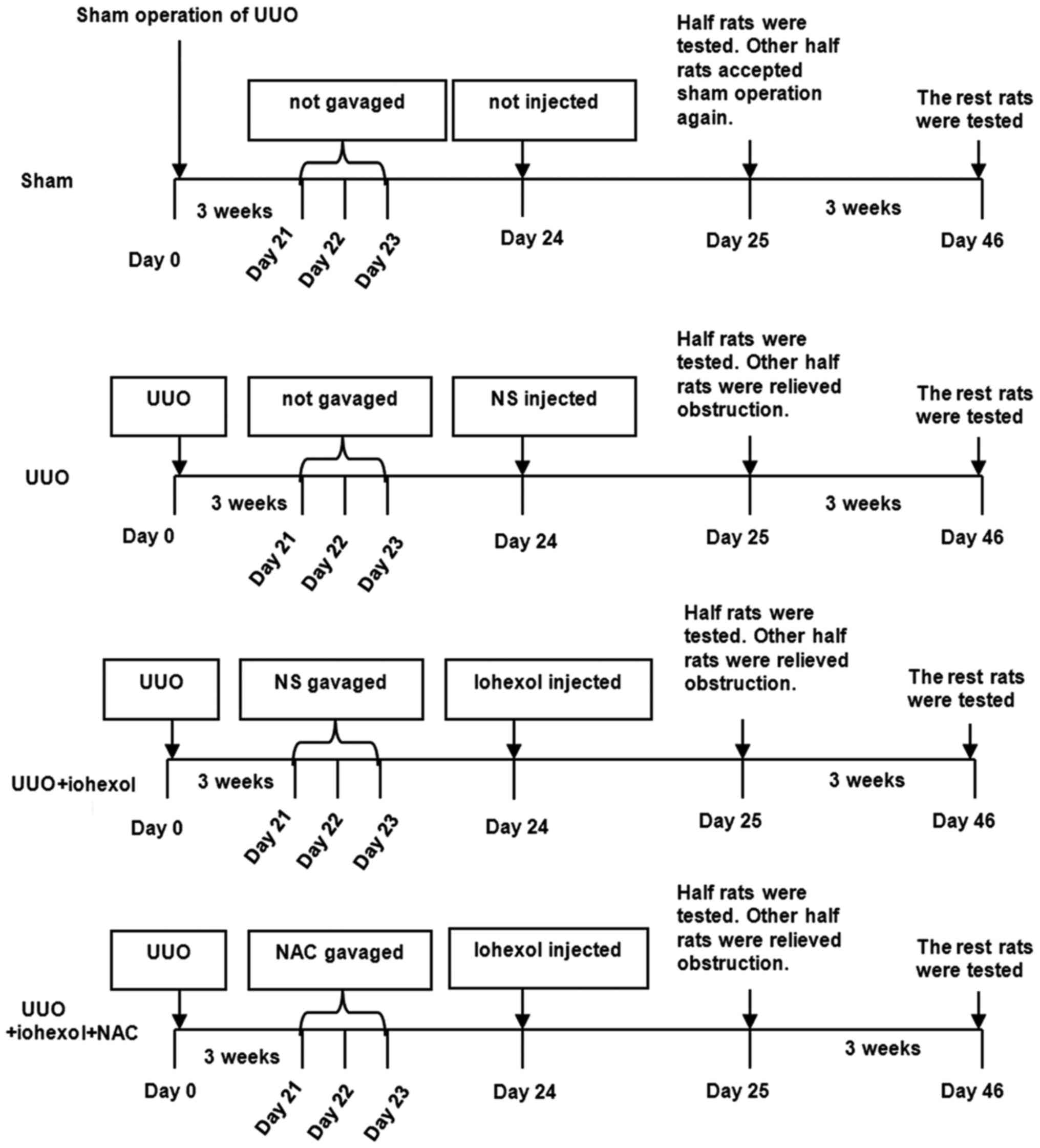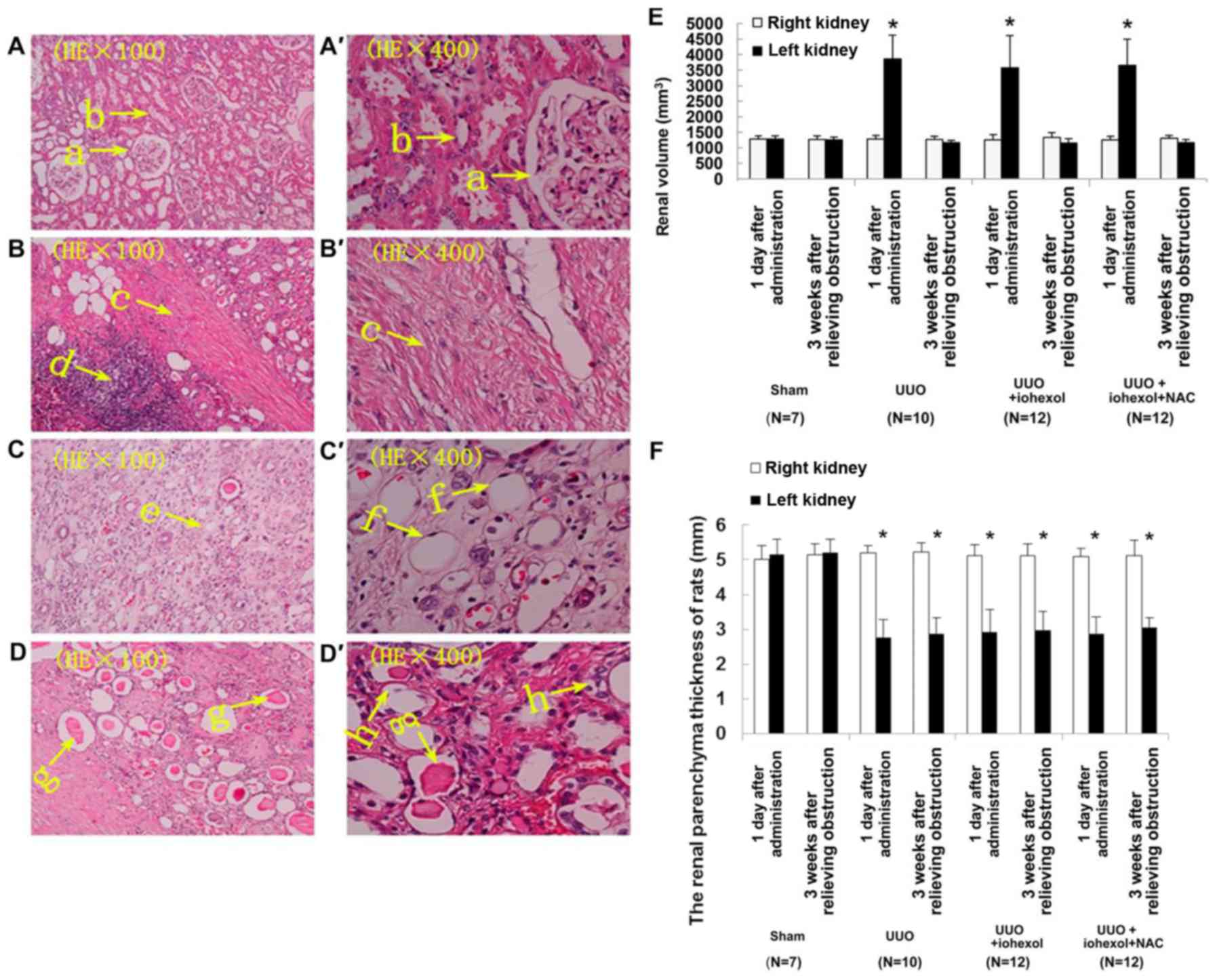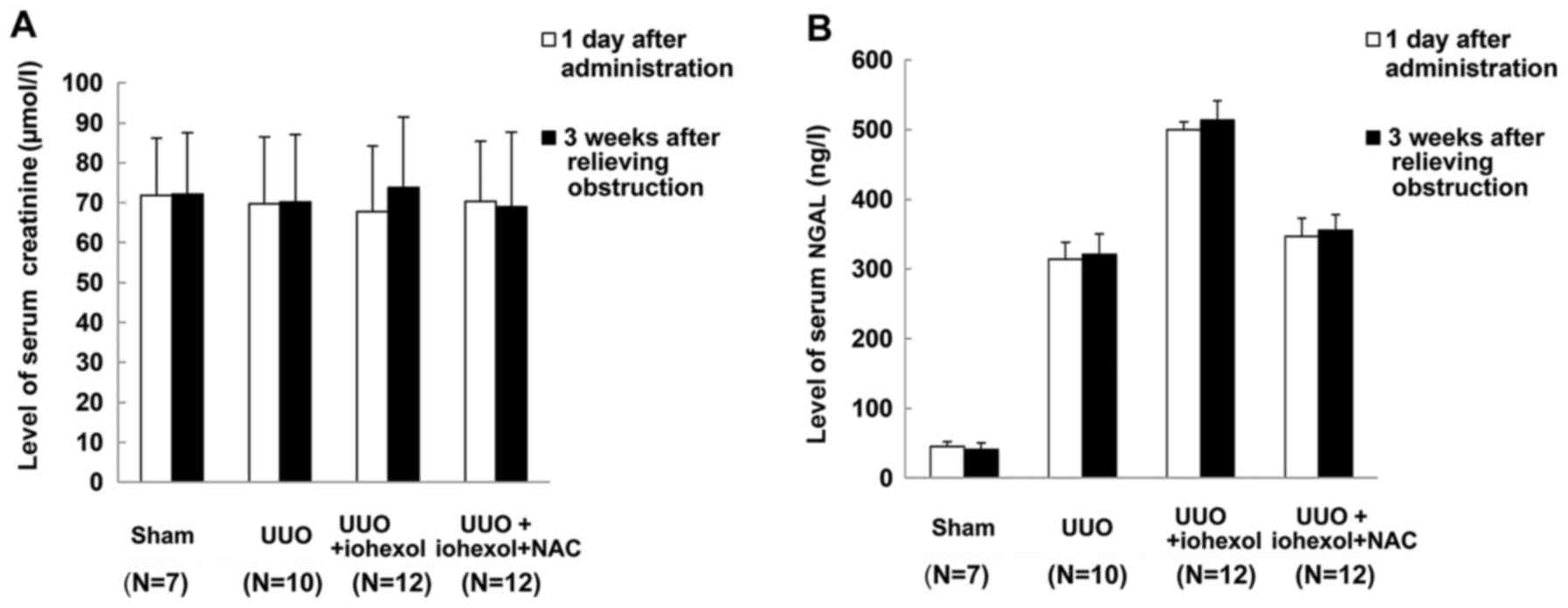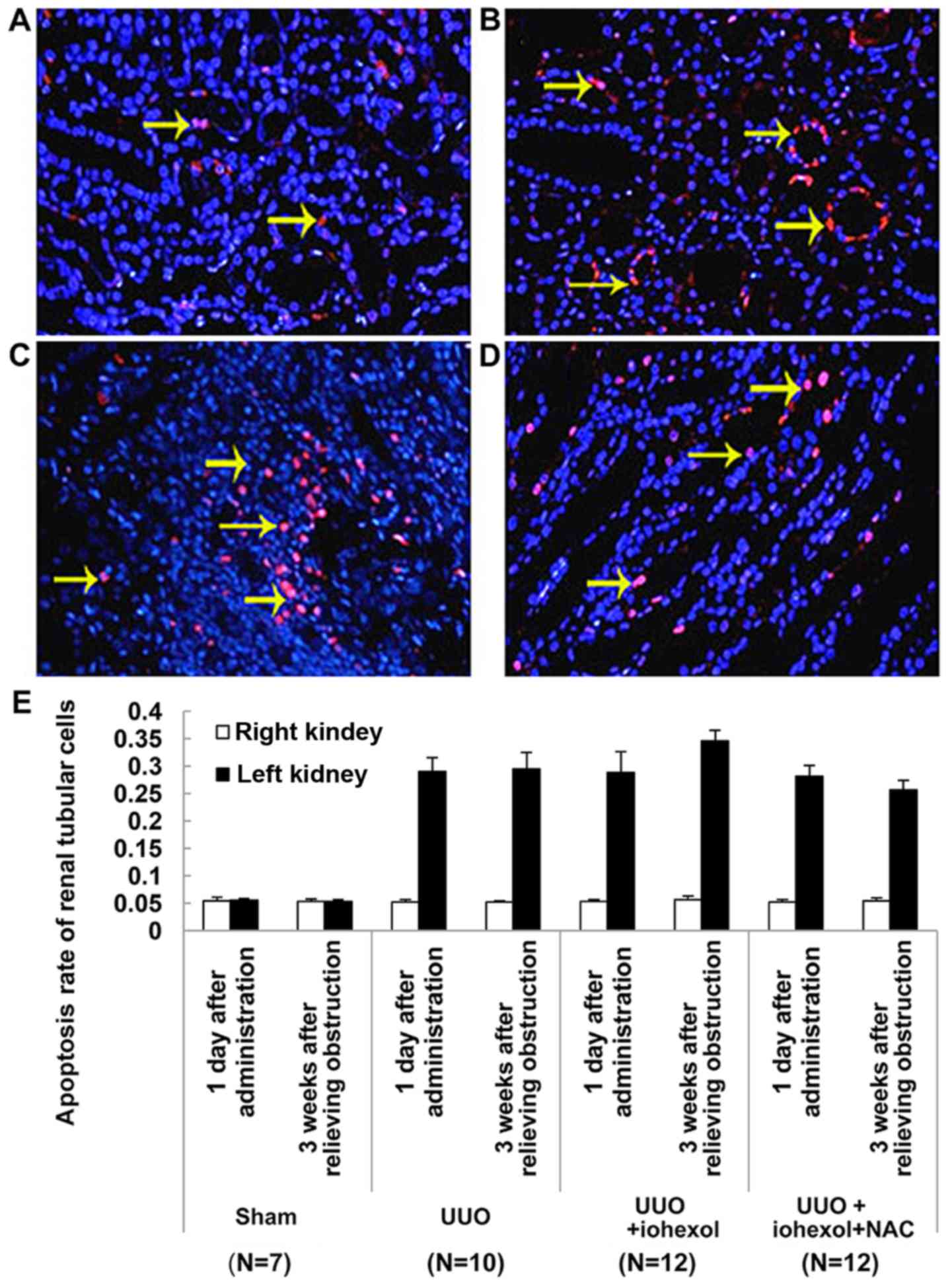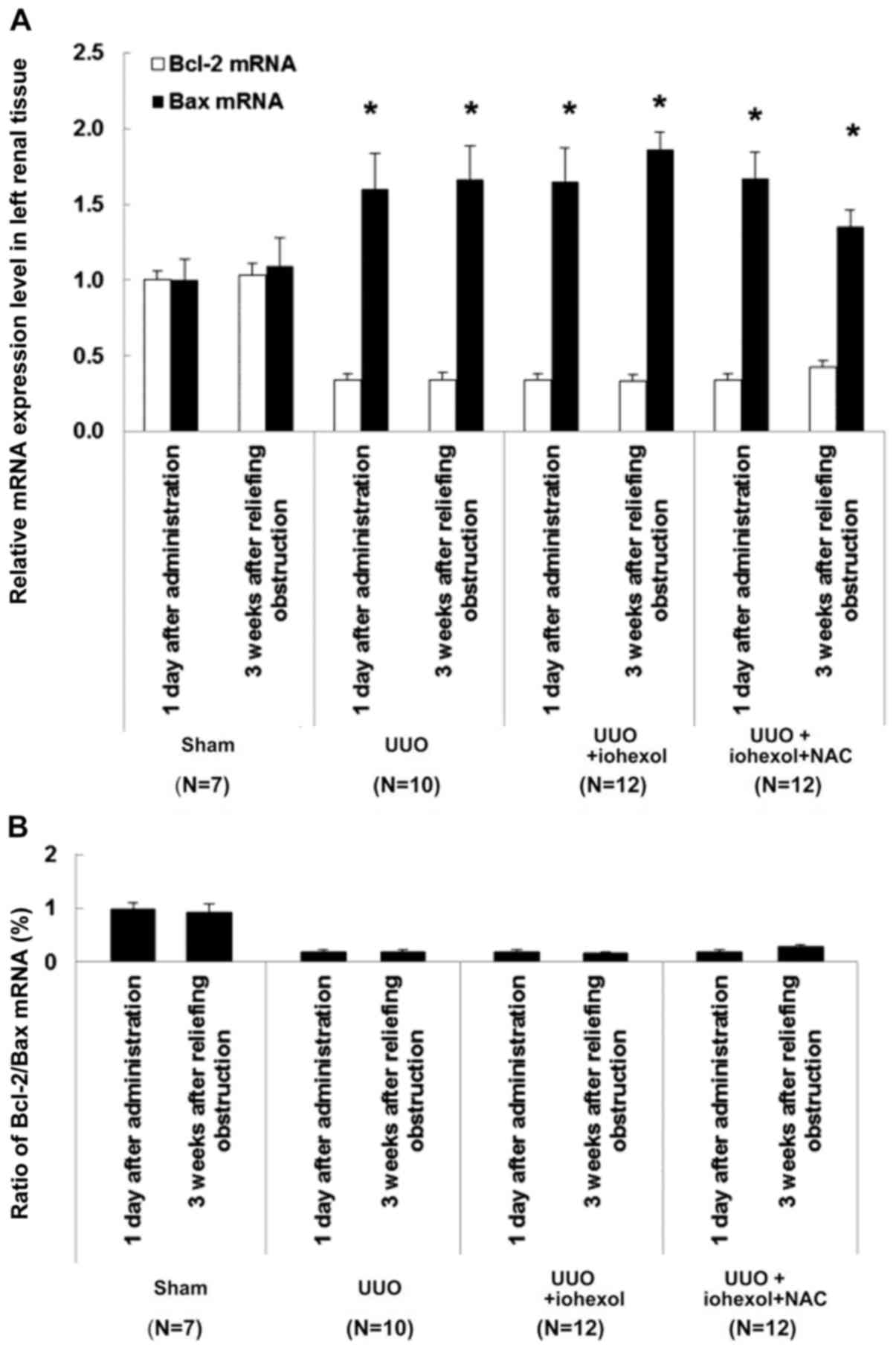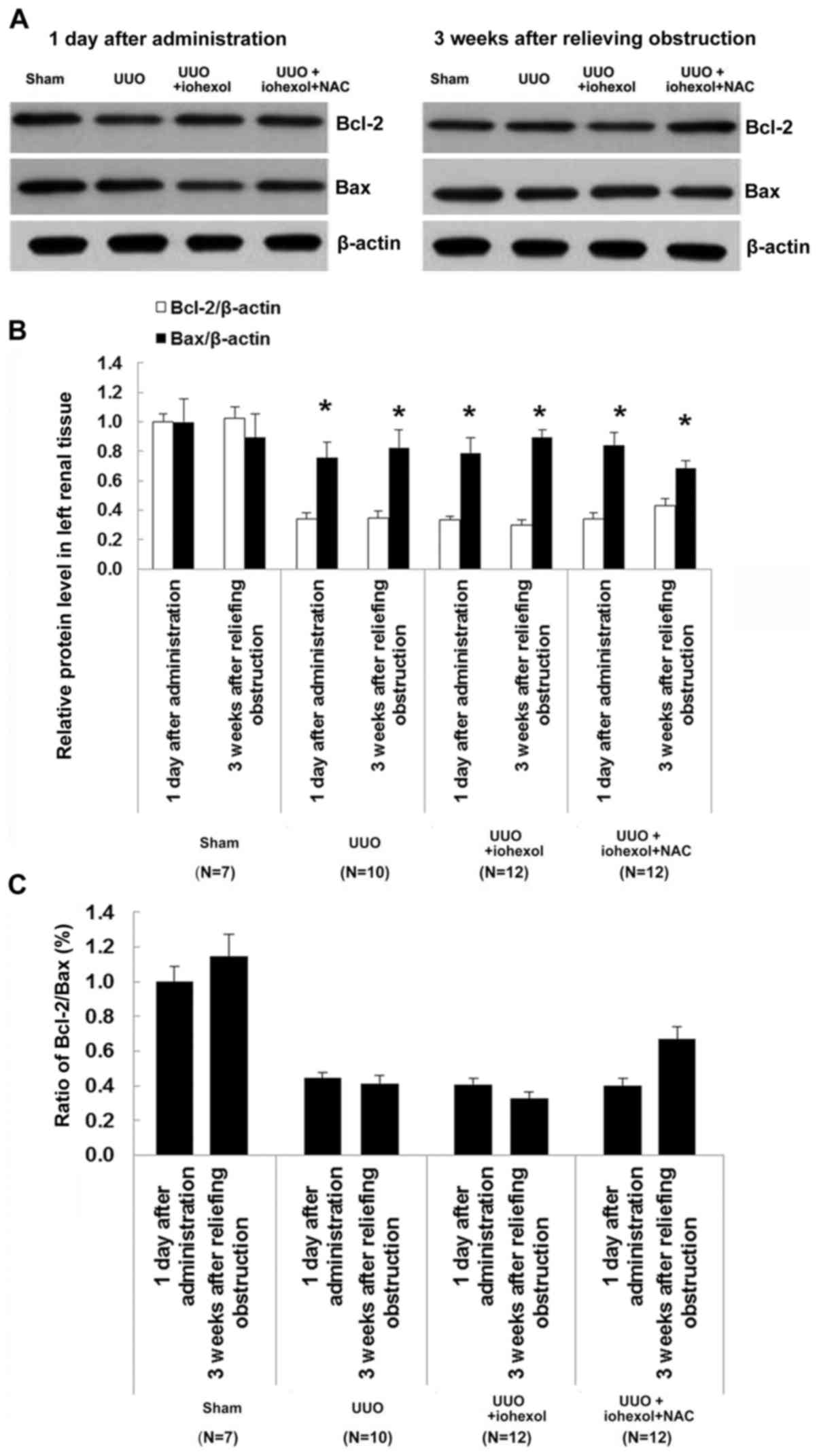|
1
|
Kumar V, Fausto N and Abbas AK: Robbins
and Cotran Pathologic Basis of Disease. 7th. Elsevier Saunders;
Philadelphia: 2005
|
|
2
|
Chevalier RL: Pathophysiology of
obstructive nephropathy in the newborn. Semin Nephrol. 18:585–593.
1998.PubMed/NCBI
|
|
3
|
Rudnick MR, Goldfarb S and Tumlin J:
Contrast-induced nephropathy: Is the picture any clearer? Clin J Am
Soc Nephrol. 3:261–262. 2008. View Article : Google Scholar : PubMed/NCBI
|
|
4
|
Berg KJ: Nephrotoxicity related to
contrast media. Scand J Urol Nephrol. 34:317–322. 2000. View Article : Google Scholar : PubMed/NCBI
|
|
5
|
Pattharanitima P and Tasanarong A:
Pharmacological strategies to prevent contrast-induced acute kidney
injury. Biomed Res Int. 2014:2369302014. View Article : Google Scholar : PubMed/NCBI
|
|
6
|
Gurm HS, Smith DE, Berwanger O, Share D,
Schreiber T, Moscucci M and Nallamothu BK; BMC2 (Blue Cross Blue
Shield of Michigan Cardiovascular Consortium), : Contemporary use
and effectiveness of N-acetylcysteine in preventing
contrast-induced nephropathy among patients undergoing percutaneous
coronary intervention. JACC Cardiovasc Interv. 5:98–104. 2012.
View Article : Google Scholar : PubMed/NCBI
|
|
7
|
Tepel M, Aspelin P and Lameire N:
Contrast-induced nephropathy: A clinical and evidence-based
approach. Circulation. 113:1799–1806. 2006. View Article : Google Scholar : PubMed/NCBI
|
|
8
|
Persson PB, Hansell P and Liss P:
Pathophysiology of contrast medium-induced nephropathy. Kidney Int.
68:14–22. 2005. View Article : Google Scholar : PubMed/NCBI
|
|
9
|
Brezis M and Rosen S: Hypoxia of the renal
medulla-its implications for disease. N Engl J Med. 332:647–655.
1995. View Article : Google Scholar : PubMed/NCBI
|
|
10
|
Tumlin J, Stacul F, Adam A, Becker CR,
Davidson C, Lameire N and McCullough PA: CIN Consensus Working
Panel: Pathophysiology of contrast-induced nephropathy. Am J
Cardiol. 98:14K–20K. 2006. View Article : Google Scholar : PubMed/NCBI
|
|
11
|
Romano G, Briguori C, Quintavalle C, Zanca
C, Rivera NV, Colombo A and Condorelli G: Contrast agents and renal
cell apoptosis. Eur Heart J. 29:2569–2576. 2008. View Article : Google Scholar : PubMed/NCBI
|
|
12
|
Kelly AM, Dwamena B, Cronin P, Bernstein
SJ and Carlos RC: Meta-analysis: Effectiveness of drugs for
preventing contrast-induced nephropathy. Ann Intern Med.
148:284–294. 2008. View Article : Google Scholar : PubMed/NCBI
|
|
13
|
Sunay M, Karakan T, Aydin A, Koca G,
Borcek P and Öğüş E: Do montelukast sodium and N-acetylcysteine
have a nephroprotective effect on unilateral ureteral obstruction?
A placebo controlled trial in a rat model. J Urol. 194:1132–1137.
2015. View Article : Google Scholar : PubMed/NCBI
|
|
14
|
Inda-Filho AJ, Caixeta A, Manggini M and
Schor N: Do intravenous N-acetylcysteine and sodium bicarbonate
prevent high osmolal contrast-induced acute kidney injury? A
randomized controlled trial. PLoS One. 9:e1076022014. View Article : Google Scholar : PubMed/NCBI
|
|
15
|
Rehman T, Fought J and Solomon R:
N-acetylcysteine effect on serum creatinine and cystatin C levels
in CKD patients. Clin J Am Soc Nephrol. 3:1610–1614. 2008.
View Article : Google Scholar : PubMed/NCBI
|
|
16
|
Chaabane W, Praddaude F, Buleon M, Jaafar
A, Vallet M, Rischmann P, Galarreta CI, Chevalier RL and Tack I:
Renal functional decline and glomerulotubular injury are arrested
but not restored by release of unilateral ureteral obstruction
(UUO). Am J Physiol Renal Physiol. 304:F432–F439. 2013. View Article : Google Scholar : PubMed/NCBI
|
|
17
|
Efrati S, Berman S, Ilgiyeav I, Siman-Tov
Y, Averbukh Z and Weissgarten J: Differential effects of
N-acetylcysteine, theophylline or bicarbonate on contrast-induced
rat renal vasoconstriction. Am J Nephrol. 29:181–191. 2009.
View Article : Google Scholar : PubMed/NCBI
|
|
18
|
Shen Y, Miao NJ, Xu JL, Gan XX, Xu D, Zhou
L, Xue H, Zhang W and Lu LM: N-acetylcysteine alleviates
angiotensin II-mediated renal fibrosis in mouse obstructed kidneys.
Acta Pharmacol Sin. 37:637–644. 2016. View Article : Google Scholar : PubMed/NCBI
|
|
19
|
Liapis H, Yu H and Steinhardt GF: Cell
proliferation, apoptosis, Bcl-2 and Bax expression in obstructed
opossum early metanephroi. J Urol. 164:511–517. 2000. View Article : Google Scholar : PubMed/NCBI
|
|
20
|
Skott M, Nørregaard R, Sorensen HB, Kwon
TH, Frøkiaer J and Nielsen S: Pre-existing renal failure worsens
the outcome after intestinal ischaemia and reperfusion in rats.
Nephrol Dial Transplant. 25:3509–3517. 2010. View Article : Google Scholar : PubMed/NCBI
|
|
21
|
Goldenberg I and Matetzky S: Nephropathy
induced by contrast media: Pathogenesis, risk factors and
preventive strategies. CMAJ. 172:1461–1471. 2005. View Article : Google Scholar : PubMed/NCBI
|
|
22
|
Devrim E, Cetin M, Namuslu M, Ergüder IB,
Cetin R and Durak I: Oxidant stress due to non ionic low osmolar
contrast medium in rat kidney. Indian J Med Res. 130:433–436.
2009.PubMed/NCBI
|
|
23
|
Nicholson T and Downes M: Contrast
nephrotoxicity and iso-osmolar contrast agents: Implications of
NEPHRIC. Clin Radiol. 58:659–660. 2003. View Article : Google Scholar : PubMed/NCBI
|
|
24
|
Yeh CH, Chiang HS, Lai TY and Chien CT:
Unilateral ureteral obstruction evokes renal tubular apoptosis via
the enhanced oxidative stress and endoplasmic reticulum stress in
the rat. Neurourol Urodyn. 30:472–479. 2011. View Article : Google Scholar : PubMed/NCBI
|
|
25
|
Weisbord SD and Palevsky PM: Prevention of
contrast-induced nephropathy with volume expansion. Clin J Am Soc
Nephrol. 3:273–280. 2008. View Article : Google Scholar : PubMed/NCBI
|
|
26
|
Baliga R, Ueda N, Walker PD and Shah SV:
Oxidant mechanisms in toxic acute renal failure. Am J Kidney Dis.
29:465–477. 1997. View Article : Google Scholar : PubMed/NCBI
|
|
27
|
Tepel M, van der Giet M, Schwarzfeld C,
Laufer U, Liermann D and Zidek W: Prevention of
radiographic-contrast-agent-induced reductions in renal function by
acetylcysteine. N Engl J Med. 343:180–184. 2000. View Article : Google Scholar : PubMed/NCBI
|
|
28
|
Shyu KG, Cheng JJ and Kuan P:
Acetylcysteine protects against acute renal damage in patients with
abnormal renal function undergoing a coronary procedure. J Am Coll
Cardiol. 40:1383–1388. 2002. View Article : Google Scholar : PubMed/NCBI
|
|
29
|
Kay J, Chow WH, Chan TM, Lo SK, Kwok OH,
Yip A, Fan K, Lee CH and Lam WF: Acetylcysteine for prevention of
acute deterioration of renal function following elective coronary
angiography and intervention: A randomized controlled trial. JAMA.
289:553–558. 2003. View Article : Google Scholar : PubMed/NCBI
|
|
30
|
Li H, Chen J, Xiong C, Wei H, Yin C and
Ruan J: Apoptosis induction by the total flavonoids from
arachniodes exilis in HepG2 cells through reactive oxygen
species-mediated mitochondrial dysfunction involving MAPK
activation. Evid Based Complement Alternat Med. 2014:9069412014.
View Article : Google Scholar : PubMed/NCBI
|
|
31
|
Yuan Y, Wang Y, Hu FF, Jiang CY, Zhang YJ,
Yang JL, Zhao SW, Gu JH, Liu XZ, Bian JC and Liu ZP: Cadmium
activates reactive oxygen species-dependent AKT/mTOR and
mitochondrial apoptotic pathways in neuronal cells. Biomed Environ
Sci. 29:117–126. 2016.PubMed/NCBI
|
|
32
|
Gao H, Li LY, Zhang M and Zhang Q:
Inactivated Sendai virus induces apoptosis mediated by reactive
oxygen species in murine melanoma cells. Biomed Environ Sci.
29:877–884. 2016.PubMed/NCBI
|
|
33
|
Jiang H, Zhao PJ, Su D, Feng J and Ma SL:
Paris saponin I induces apoptosis via increasing the Bax/Bcl-2
ratio and caspase-3 expression in gefitinib-resistant non-small
cell lung cancer in vitro and in vivo. Mol Med Rep. 9:2265–2272.
2014.PubMed/NCBI
|




